It’s been a long hard road to bring the space shuttle fleet back to service after falling foam led to the destruction of Columbia. Although Discovery launched again last year, hopes sunk after the external fuel tank shed foam again, even after all the new safety measures taken by NASA. Once again, NASA thinks it’s ready for launch. This time Discovery will blast off on July 1, to link up with the International Space Station. But the launch decision didn’t come easy.
Continue reading “Discovery will Launch July 1, Despite Objections”
Discovery Prepares for Launch
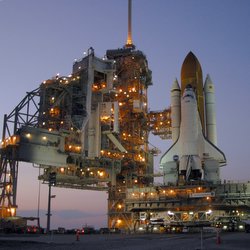
Discovery at the launch pad. Image credit: NASA. Click to enlarge
After another long delay, NASA’s space shuttle fleet is nearly ready to get flying again. Discovery rolled out to the launch pad on Friday to prepare for its upcoming launch, returning the fleet to service, and continuing the construction of the International Space Station. Discovery’s launch window opens up on July 1, and extends until July 19. If all goes well, the shuttle will spend 12 days in space, testing new hardware and safety techniques, and delivering supplies to the station.
The Space Shuttle Discovery stands at its launch pad at NASA’s Kennedy Space Center, Fla. The shuttle arrived at 8:30 p.m. EDT Friday on top of a giant vehicle known as the crawler transporter.
“Rollout of Space Shuttle Discovery signifies the last major processing milestone in preparation for our next mission, STS-121,” said Space Shuttle Program Manager Wayne Hale. “The entire team has worked tremendously hard to ensure we were prepared to move to the pad, and we are excited to continue moving toward a July launch.”
The crawler transporter began carrying Discovery out of Kennedy’s Vehicle Assembly Building at 12:45 p.m. Friday. The crawler’s maximum speed during the 4.2-mile journey was less than 1 mph.
While at the pad, the shuttle will undergo final testing and hardware integration prior to launch, as well as a “hot fire” test of the auxiliary power units to ensure they are properly functioning. The rotating service structure then will be moved back around the vehicle to protect it from potential damage and the elements.
Discovery’s launch to the International Space Station is targeted for July 1, with a launch window that extends until July 19. During the 12-day mission, Discovery’s crew will test new hardware and techniques to improve shuttle safety, as well as deliver supplies and make repairs to the station.
Another upcoming milestone is the terminal countdown demonstration test, set for June 12 through 15. This countdown dress rehearsal provides each shuttle crew with the opportunity to participate in various simulated countdown activities, including equipment familiarization and emergency evacuation training.
Audio clips of additional comments from Wayne Hale are available at:
http://www.nasa.gov/formedia
For information about the STS-121 mission and its crew, visit:
http://www.nasa.gov/shuttle
Original Source: NASA News Release
Discovery Launch Window Set for July
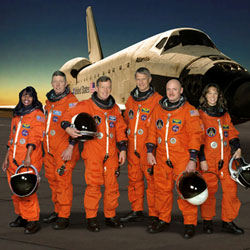
The crew of STS-121 and the space shuttle. Image credit: NASA. Click to enlarge.
The launch of the space shuttle Discovery has been pushed back until July to give engineers time to fix a sensor on the external fuel tank. The new launch window opens up on July 1, and lasts until July 19, 2006. If all goes well, Discovery will lift off and rendezvous with the International Space Station. The 7-member crew of astronauts will deliver supplies to the station, and continue testing post-Columbia upgrades and repair techniques.
NASA announced today July 1 to 19, 2006, is the new launch planning window for Space Shuttle Discovery’s mission (STS-121). The window gives the agency time to do additional engineering work and analysis to ensure a safe flight for Discovery and its crew.
Space Shuttle Program Manager Wayne Hale made the announcement during a news conference from NASA’s Johnson Space Center in Houston. The decision to target July followed a two-day meeting on the external fuel tank’s engine cutoff (ECO) sensors. The sensors indicate whether the tank still has fuel during liftoff. During testing, one of the four ECO sensors had a slightly different reading than is expected. Shuttle officials have decided they will remove and replace all four liquid hydrogen sensors.
“We’ve been saying for months that our engineering work would determine when we fly our next mission. Targeting July is the right choice in order to make smart decisions,” said Bill Gerstenmaier, NASA associate administrator for Space Operations.
Other issues factored into the decision to adjust the STS-121 planning window:
* Testing and analysis are required on the shuttle’s modified external tank. The testing will help verify the tank is safe to fly without the protuberance air load (PAL) foam ramp. The PAL ramp was removed after a large piece of foam fell from that area during Discovery’s July 2005 launch. More analysis is needed to decide whether changes are needed on the tank’s ice frost foam ramps.
* Repair work on the shuttle’s robotic arm must be completed. Technicians on a work platform accidentally bumped the arm last week, causing a tiny crack. The arm will be removed for repair.
The STS-121 mission will take Shuttle Commander Steve Lindsey and six crew members to the International Space Station. This is the second mission in the Return to Flight sequence to evaluate new heat shield inspection and repair techniques and to deliver supplies and equipment to the station.
For information about the Space Shuttle Program, the STS-121 mission and its crew, visit:
http://www.nasa.gov/shuttle
Original Source: NASA News Release
Next Shuttle Will Fly in March 2006
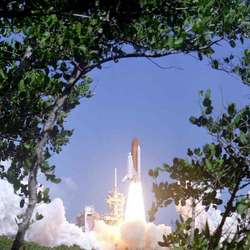
Discovery lifts off on the 26th, July. Image credit: NASA/Bill Ingalls Click to enlarge
NASA is targeting March for the next Space Shuttle mission (STS-121). The mission will be the second test flight to the International Space Station in the Shuttle Return to Flight sequence.
NASA Administrator Michael Griffin and Associate Administrator for Space Operations Bill Gerstenmaier made the announcement today at a news conference at the agency’s headquarters in Washington.
“We are giving ourselves what we hope is plenty of time to evaluate where we are,” said Administrator Griffin. “We don’t see the tasks remaining before us being as difficult as the path behind us.”
Based on NASA’s self-imposed optimum lighting requirements, the earliest possible launch opportunity for the STS-121 mission is March 4, 2006. The Space Shuttle Discovery will be used for the mission, instead of Space Shuttle Atlantis.
Moving toward a no earlier than March launch for STS-121 will allow engineering teams more time to properly evaluate the issue of large pieces of insulating foam that came off Discovery’s external fuel tank during launch last month.
Targeting March also allows the Space Shuttle Program to put itself into a better posture for future Shuttle missions to the Space Station. Changing Orbiters for the STS-121 mission enables use of Atlantis for the following mission, STS-115, which will resume assembly of the Station.
The switch frees Atlantis to fly the remaining Space Station truss segments, which are too heavy for Discovery, in 2006. By changing the Orbiter line up, the Shuttle program will not have to do two back-to-back missions with Atlantis, as previously scheduled.
“It really makes sense to move to the March timeframe,” Gerstenmaier said. “We’re looking at the Shuttle missions to support the most robust flight sequence for the Space Station and to make the whole sequence flow better. This extra time helps us make sure that all the work we need to do fits and that there are no other issues.”
Discovery’s recent mission, STS-114, and the STS-121 mission are test flights. They will enable NASA to evaluate new safety procedures and equipment, giving the agency greater confidence that the Shuttle can be flown safely through its planned retirement date of 2010.
The external fuel tanks at NASA’s Kennedy Space Center in Florida will be shipped back to the Michoud Assembly Facility in Louisiana for tests and potential modifications.
For information about the STS-114 Return to Flight mission and future Shuttle flights, visit: http://www.nasa.gov/returntoflight
Original Source: NASA News Release
NASA Celebrates Discovery’s Return
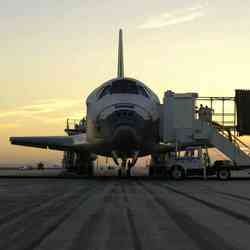
Discovery resting on the runway at Edwards Air Force Base. Image credit: NASA Click to enlarge
The Space Shuttle Discovery is home after a 14-day, 5.8 million-mile journey in space. The mission included breathtaking in-orbit maneuvers, tests of new equipment and procedures, a first-of-its-kind spacewalking repair, and virtual visits with two heads of state.
Commander Eileen Collins and the crew of the STS-114 mission, Jim Kelly, Charlie Camarda, Wendy Lawrence, Steve Robinson, Andy Thomas and Soichi Noguchi of Japan, landed at Edwards Air Force Base, Calif., at 8:12 EDT this morning.
“We have had a fantastic mission,” Collins said shortly after the crew disembarked from the Shuttle. “We brought Discovery back in great shape. This is a wonderful moment for us all to experience.”
Discovery’s mission, the first of two Return to Flight test missions following the 2003 Columbia accident, was one of the most complex space flights in NASA history. The crew flawlessly executed its to-do list.
After an on-time lift-off from KSC on July 26, the crew tested new capabilities and techniques developed over the past two-and-one-half years to inspect and possibly repair the Space Shuttle in orbit. Collins guided Discovery through an unprecedented back flip maneuver as it approached the International Space Station. The maneuver allowed the Station crew to snap high-resolution photos that added to the wealth of new data mission managers used to ensure Discovery was in good shape to come home.
“It’s going to be hard to top this mission,” NASA Administrator Michael Griffin said. “Everywhere you look, there’s nothing but outstanding success.”
Robinson and Noguchi, with the help of crewmates, completed three spacewalks. The astronauts repaired one Space Station Control Moment Gyroscope and replaced another. Their efforts put all four of the Station’s gyros back into service. They also tested new repair techniques for the Space Shuttle’s heat-shielding outer skin and installed equipment outside the Station.
When two thermal protection tile gap-fillers were spotted jutting out of Discovery’s underside, astronauts and other experts on the ground pulled together to devise a plan to prevent the protrusions from “tripping the boundary layer,” causing higher temperatures on the Shuttle during atmospheric re-entry. Ground controllers sent up plans to the Shuttle-Station complex for Robinson to ride the Station robotic arm beneath the Shuttle and, with surgical precision, pluck out the gap-fillers. Work on the Shuttle underbelly had never been tried before, but with Thomas coordinating, Lawrence and Kelly operating the robotic arms, and fellow spacewalker Noguchi keeping watch, Robinson delicately completed the extraction.
Discovery’s astronauts and the Station crew, Russian Sergei Krikalev and American John Phillips, transferred more than 12,000 pounds of equipment and supplies to the Station. Discovery returned about 7,000 pounds of Station material back to Earth.
The crew got phone calls from two world leaders. President George W. Bush and Japanese Prime Minister Junichiro Koizumi offered congratulations and appreciation for all the astronauts’ hard work.
Commander Collins and the crew also paid tribute to the fallen astronauts of Columbia, as well as others who gave their lives for space exploration.
Over the next several weeks, engineers will process data from STS-114, the first of two test missions for the Space Shuttle. Teams are already at work looking into why a large piece of foam fell off the External Tank during ascent. NASA managers have committed to understanding why the foam came off the tank, and remedying it if necessary, before clearing the next Space Shuttle Return to Flight test mission, STS-121, for flight.
The Discovery astronauts will spend the next few days undergoing medical checkouts, reuniting with their families, and returning to Houston. In about a week, after undergoing preparations at Edwards, Discovery will be ferried back to NASA’s Kennedy Space Center, Fla., atop a modified Boeing-747 aircraft.
For more about the Return to Flight mission, visit:
http://www.nasa.gov/returntoflight
Original Source: NASA News Release
Discovery Lands Safely at Edwards
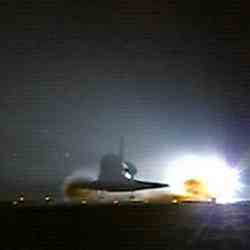
Discovery’s touchdown. Image credit: NASA Click to enlarge
Discovery glided to a pre-dawn landing at Edwards Air Force Base in California this morning concluding a journey of 5.8 million miles, touching down at 7:11 a.m. CDT.
The landing marked the sixth night landing at Edwards Air Force Base, and the 50th time overall that a Shuttle concluded its mission in the California desert.
Commander Eileen Collins and Pilot Jim Kelly, assisted by Mission Specialist Steve Robinson, began Discovery?s return to earth by firing the spacecraft’s orbital maneuvering system engines to slow its speed and begin its descent. Discovery’s ground track took it from the firing of the 2 minute, 42-second deorbit burn at 6:06 a.m. over the western Indian Ocean, traveling in a loop around Australia, then northeast across the Pacific, across the California coast north of Los Angeles and then to Edwards.
Persistent thunderstorms at the primary landing site in Florida resulted in a wave-off of two opportunities to return to the launch site today.
The STS-114 flight of Discovery with Collins, Kelly, Robinson and Mission Specialists Soichi Noguchi of the Japanese Aerospace Exploration Agency, Andy Thomas, Wendy Lawrence and Charlie Camarda provided unprecedented information on the condition of an orbiter in space. Noguchi and Robinson did three successful spacewalks at the International Space Station and Discovery transported tons of equipment and supplies to and from the Station.
From the Station, Commander Sergei Krikalev and NASA Science Officer John Phillips sent their congratulations to Discovery?s crew and the flight control team in Houston.
Discovery?s crew will have a welcome home ceremony at 3 p.m. Wednesday at Houston?s Ellington Field.
Original Source: NASA News Release
Shuttle Landing Delayed to Tuesday
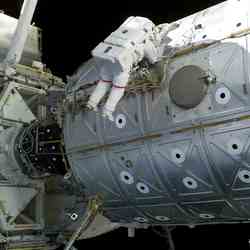
Mission specialist Soichi Noguchi. Image credit: NASA Click to enlarge
Discovery’s seven astronauts will spend another day in space after weather conditions at the Kennedy Space Center landing site prevented a return to Earth today.
Discovery’s two landing opportunities to Florida were waved off this morning due to unpredictable cloud cover at the landing site.
All three primary Shuttle landing sites will be activated on Tuesday. NASA’s Kennedy Space Center, Florida, will remain the preferred landing site. Edwards Air Force Base, California, will be second in preference for landing and White Sands Space Harbor, New Mexico, will be third in preference. Two Shuttle landing opportunities will be available at each site.
Weather conditions at KSC for Tuesday are forecast to be similar to today with a slight chance of showers offshore. Edwards is forecast to have acceptable conditions for landing. White Sands’ forecast includes a chance of showers.
Preparations are now focused on the first opportunity to land Tuesday which would begin with an engine firing by Discovery at 3:01 a.m. CDT and lead to a touchdown at KSC at 4:07 a.m. CDT. The additional landing opportunities include: a 4:33 a.m. Shuttle engine firing leading to a 5:39 a.m. landing at White Sands; a 4:37 a.m. engine firing leading to a 5:43 a.m. touchdown at KSC; a 6:06 a.m. engine firing leading to 7:12 a.m. touchdown at Edwards; a 6:09 a.m. engine firing leading to a 7:13 a.m. landing at White Sands; and a 7:44 a.m. engine firing leading to a 8:47 a.m. landing at Edwards.
The Shuttle crew will fire Discovery’s engines at 7:19 a.m. today to adjust the Shuttle’s orbit and optimize the landing opportunities for tomorrow. The crew will go to sleep at 11:39 a.m. and awaken at 7:39 p.m. to begin deorbit preparations.
Original Source: NASA News Release
Discovery and ISS Will Be Visible in the Southeast US
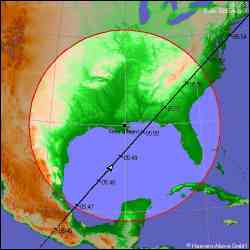
Discovery’s ground track on August 6th. Image credit: Chris Peat and Heavens Above. Click to enlarge
If you live in south Florida, central Texas or near the Mississippi River Delta, you’re in for a treat. This weekend the space shuttle Discovery and the International Space Station (ISS) are going to orbit over your part of the country. Shining like very bright stars, the two ships will glide in tandem across the sky–a lovely sight.
That’s the good news. The bad news is that you have to wake up before dawn to see them, but they’re worth waking up for.
The flybys commence on Saturday morning, August 6th, at 05:50 a.m. CDT when the pair can be seen from New Orleans, Mobile, Biloxi and surrounding areas. Discovery will have just undocked from the ISS about three hours earlier. This means the two ships will be separated, but still close together. Side by side apparitions of two bright spaceships are rare and beautiful.
“Based on their predicted separation of 7 km, their angular separation should be 1o–only twice the diameter of a full moon,” says independent satellite tracking expert Ted Molczan.
Which ship is which? The brighter light is the shuttle. Although Discovery is smaller than the ISS, its super-white top reflects more sunlight. Both ships should be easy to see in the deep-blue dawn sky.
Bonus: Discovery and the ISS, coincidentally, pass close to the planet Mars. If you’re an early riser, you’ve probably noticed Mars shining high in the sky before sunrise. If you haven’t noticed Mars yet, you will on August 6th. Discovery and the ISS will lead you right to the red planet: sky map.
August 7th should be a good morning, too, with flybys over south Florida, parts of Texas and Oklahoma. By then, says Molczan, “the two ships will be more than 250 km apart; the ISS would trail Discovery by 30 seconds or so — still worth observing, but not as spectacular as on August 6th.” Miami and Dallas are favored with particularly good apparitions: the two spaceships will be bright and, once again, close to Mars when they pass overhead.
Finally, on the morning of August 8th, the shuttle is due to land at the Kennedy Space Center. Reentry won’t be visible from much of the United States. The shuttle’s intended trajectory takes it over the Yucatan Peninsula and the Gulf of Mexico.
To the unaided eye, Discovery and the ISS are compact points of light. You can’t actually discern, e.g., the wings of the shuttle or the station’s vast solar arrays.
How about looking through a telescope?
It’s not easy, but it can be done. The two spaceships move slowly across the sky, taking about five minutes to cross from horizon to horizon. With a little practice, you can train a small telescope on the pair and manually track them. Then you can see their outlines. The space station’s T-shaped solar arrays are eye-catching; people who have seen them are impressed by their eerie copper color.
If you’ve never seen a shuttle flyby before, however, don’t spend precious minutes fumbling with a telescope. Look up and, using nothing but your eyes, simply enjoy the view.
Original Source: NASA News Release
Astronauts Remember Columbia Crew
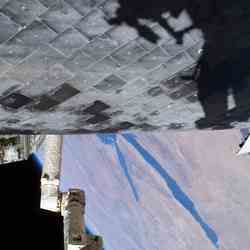
Discovery’s heat shielding tiles. Image credit: NASA Click to enlarge
Space Shuttle Discovery?s heat shield is cleared for the return to Earth early Monday after mission managers decided today that a fourth spacewalk to deal with a puffed out thermal blanket is unnecessary. Wind tunnel tests overnight at NASA?s Ames Research Center in California showed little chance of any significant debris coming from the blanket at supersonic speeds. Further engineering analysis showed any debris released from the blanket was unlikely to hit structures on Discovery.
Thursday?s Mission Management Team decision put to rest the work that was being done to assess the health of the thermal protection system. The tiles and reinforced carbon-carbon on Discovery?s wings and nose were cleared earlier for entry.
Discovery and International Space Station crewmembers Thursday delivered a moving tribute to members of the Columbia crew and others, astronauts and cosmonauts, who lost their lives in the human exploration of space.
Each crewmember, in red shirt with Columbia’s STS-107 mission patch spoke during the tribute as the docked spacecraft flew over the southern Indian Ocean approaching a sunset. Station Science Officer John Phillips said: “To the crew of Columbia, as well as the crews of Challenger, Apollo 1, Soyuz 1 and 11, and to those who have courageously given so much, we now offer our enduring thanks.?
Mission Specialist Soichi Noguchi of the Japan Aerospace Exploration Agency repeated Phillips’ words in Japanese during the tribute, and Station Commander Sergei Krikalev spoke them in Russian. For the text of the tribute, please see:
http://www.nasa.gov/returntoflight/crew/sts114_exp11_tribute.html
After their successful Wednesday spacewalk, Discovery and Station crewmembers continued transfer activities, mostly packing the Multi-Purpose Logistic Module Raffaello with items from the Station. The pressurized cargo carrier is to be unberthed Friday from the Station’s Unity Node and returned to Discovery’s cargo bay for the trip back to Earth.
Pilot Jim Kelly and Mission Specialist Wendy Lawrence attached the Station’s Canadarm2 to Raffaello in preparation for its unberthing.
Discovery Commander Eileen Collins, spacewalking Mission Specialist Steve Robinson and Mission Specialist Charlie Carmada talked with reporters from the Associated Press and NBC. A little later Collins and Noguchi spoke with Japanese Prime Minister Junichiro Koizumi, Japanese astronaut Mamoru Mohri and others, including Japanese students.
Crewmembers had an hour together for a common meal, then the seven Discovery astronauts had the afternoon off. The Station crew spent about two hours preparing equipment for the unberthing of Raffaello.
Original Source: NASA News Release
Space Shuttle Cleared for Landing
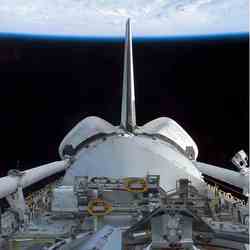
Discovery in orbit. Image credit: NASA Click to enlarge
Space Shuttle mission managers today completed their assessment of Discovery’s fitness to handle the rigors of re-entry into the atmosphere.
“We have cleared Discovery to re-enter,” said Wayne Hale, chairman of the Mission Management Team (MMT), during a news conference at NASA’s Johnson Space Center, Houston.
The MMT determined the Orbiter’s heat shield and other systems are in good shape. They also decided a spacewalk is unnecessary to repair damage to a thermal blanket on Discovery’s outer skin.
Earlier this week, Discovery (STS-114) mission managers determined two components of the Shuttle’s Thermal Protection System, tile and Reinforced Carbon-Carbon, were fit for re-entry and landing. Today, the MMT cleared the final element: thermal blankets. One blanket is slightly torn and billowing in orbit.
The MMT considered the results of overnight testing at NASA’s Ames Research Center, Moffett Field, Calif. Engineers ran samples of torn thermal blankets through wind tunnels at velocities many times faster than the speed of sound. Tests showed it was highly unlikely the blanket would tear off or strike the Orbiter. Other analyses showed the blankets would still protect Discovery from re-entry heat.
Based on the analysis of the blankets and considering the risks of a fourth spacewalk, mission managers decided the torn blanket did not need repair. “We’ve assessed this risk to the very best of our knowledge, and we believe the risk is small,” Hale said.
New imaging capabilities developed after the Space Shuttle Columbia accident allowed mission managers to see and analyze the torn thermal blanket. Data from the images were used to re-create blanket samples for the wind tunnel tests. “I think it’s remarkable we have capability to look at these small things in flight,” Hale said.
Discovery is set to land Monday, Aug. 8 at NASA’s Kennedy Space Center, Fla. The first opportunity for Commander Eileen Collins to land the Space Shuttle is at 4:46 a.m. EDT.
For information about STS-114 on the Web, visit:
http://www.nasa.gov/returntoflight
Original Source: NASA News Release
